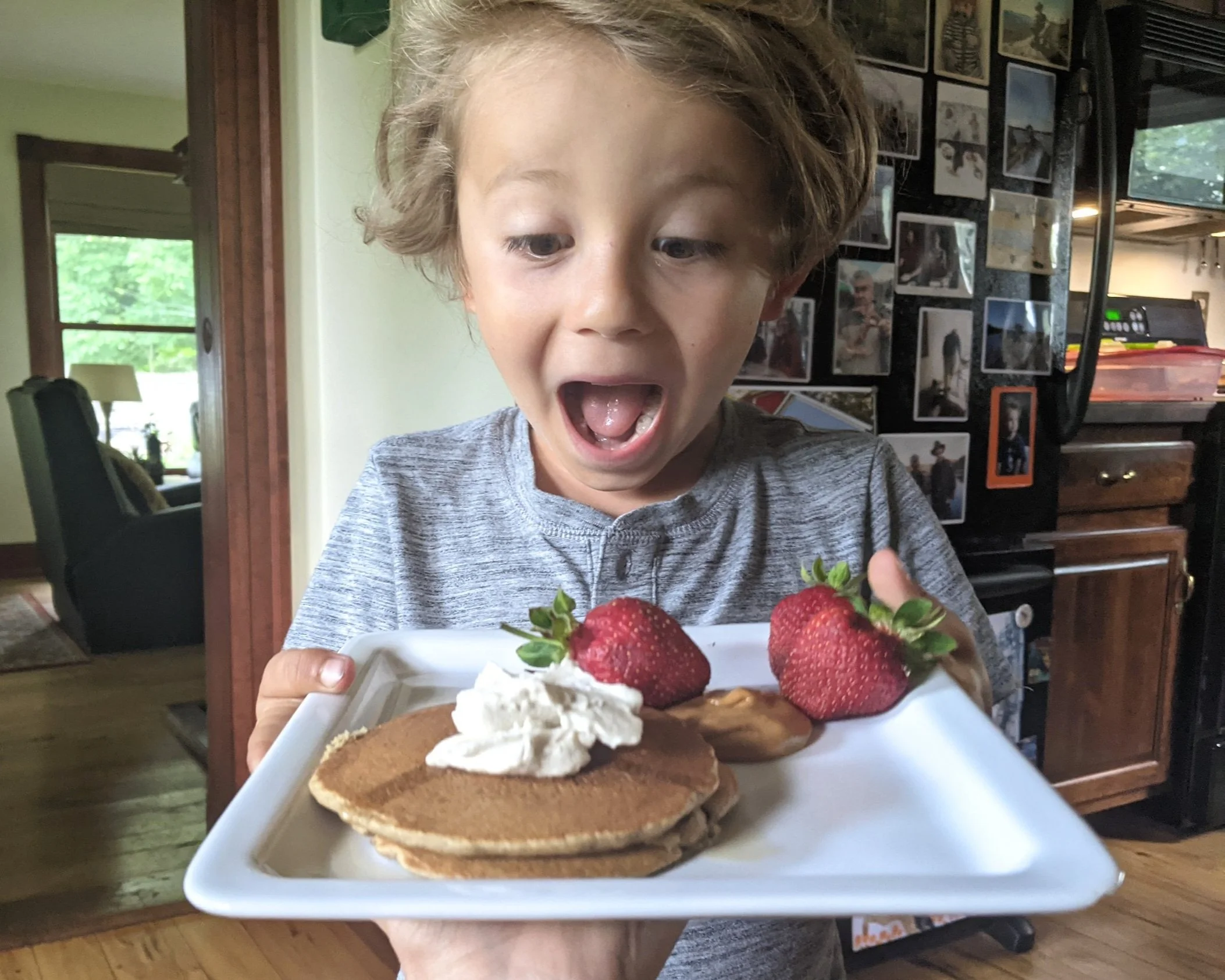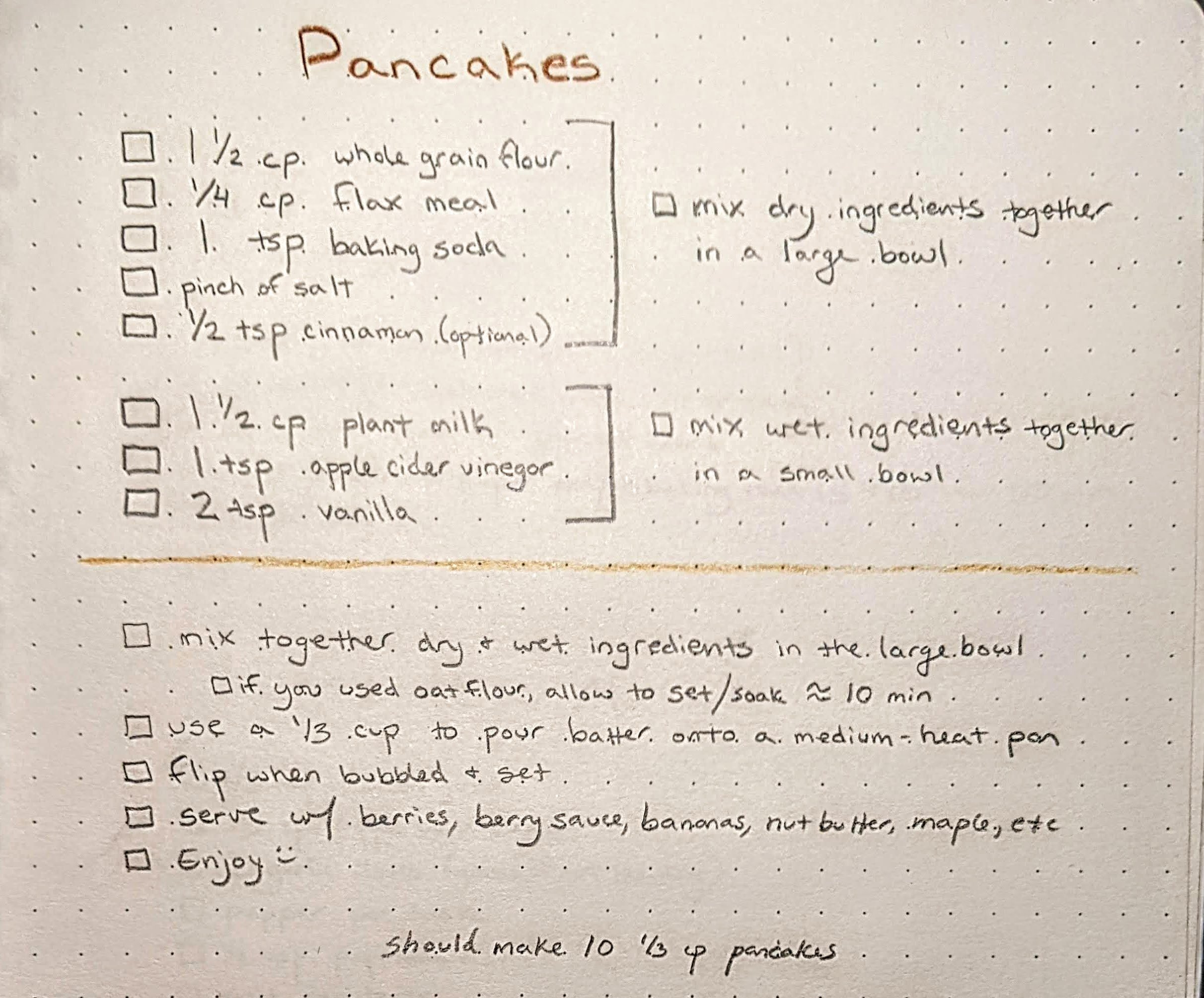Pancake Recipe (whole-food, GF option)
Gluten free? Buckwheat is an easy alternative. Worried that buckwheat has gluten in it due to the latter part of its name? Fear not, buckwheat is to wheat as a seahorse is to a horse. :-)
Don’t have whole-grain flour on hand? Throwing oats into a blender will get you oatflour in under a minute. Just follow the notes above and give it a few more minutes to set, as the batter will seem super runny until the oats soak up the liquid.
Don’t have any whole-grains on hand? This’ll work swell with all-purpose flour too, but see below for information on the importance of whole grains.
Ingredients needed for a batch of pancakes
Writing recipes over here is like pulling teeth (sorry for the long delays between them), and Crystal and I filled a long session this morning vent-gushing over the myriad recipes clattering around in our cook-by-smell/taste/sense selves. Though these recipes are often churned out weekly for years, they exist only in our hands, and finding time to settle ourselves down to pull the various threads from head & memory seems to get forever back-burned in the grand cooking of life.
These pancakes are one such recipe. They’ve been kicking around for almost 2 years now, they are a frequent Sunday treat whipped up with extras to fuel us through a week, and they are so loved they’ve yet to hit the crisped state of “I’m over _____” from my dramatic taste-whim kiddo.
If you’re a fan of buttermilk pancakes, these were reverse engineered to be similar. Back in the days when we still did dairy, we knew that if we didn’t have buttermilk on-hand we could add vinegar to milk to get a similar result; so in that same vein, these involve adding a little apple cider vinegar to the plant-milk. It makes for a fluffier & deeper-flavored pancake. If there are any left (or if you make a double batch for extras), simply pop them in the microwave for 30 seconds and eat them through the week with your heart’s topping desire.
Also, if you (like I once did & like all these online recipes herald) think that eggs are the secret ingredient to pancakes and you can’t have a fluffy cake without one, I’m here to burst that bubble with the wondrous powers of the humble flax seed. Not only is flax cheap as heck, it’s a compassionate pivot that is also sustainable, and it’s a cardiovascular (and whole-health) superpower … unlike eggs. Says who? Here’s a clipping from the Journal of the American Heart Association:
Besides the very high cholesterol content (237 mg in a 63 g egg; almost as much as in a 12‐ounce beef burger), egg yolk is high in phosphatidylcholine, which is converted by the intestinal bacteria to trimethylamine. Absorbed trimethylamine is oxidized in the liver to trimethylamine N‐oxide (TMAO), which caused atherosclerosis in an animal model. Among 4007 patients referred to the Cleveland Clinic for coronary angiograms, those with TMAO levels in the top quartile had a 2.5‐fold increase in the 3‐year risk of stroke, myocardial infarction, or vascular death.16 The other dietary substance that is largely responsible for the formation of TMAO is carnitine, mainly from red meat. Among people with impaired kidney function, high levels of TMAO accelerate the decline of renal function and increase mortality. There is a linear dose response of TMAO with egg consumption.17
Eggs also increase the risk of type 2 diabetes mellitus. This has been known for some time. An increase in the risk of type 2 diabetes mellitus with egg consumption was confirmed in several recent meta‐analyses.
Also, this may not be widely known outside the vegan community, but if you’ve ever wondered what happens with male chicks (because only the females are kept around for ovulating out eggs for humans), here’s a mind/heart slap from Wikipedia:
Chick culling or unwanted chick killing is the process of separating and killing unwanted (male and unhealthy female) chicks for which the intensive animal farming industry has no use. It occurs in all industrialised egg production, whether free range, organic, or battery cage. Worldwide, around 7 billion male chicks are culled each year in the egg industry.[1] Because male chickens do not lay eggs and only those in breeding programs are required to fertilize eggs, they are considered redundant to the egg-laying industry and are usually killed shortly after being sexed, which occurs just days after they are conceived or after they hatch.[1] Some methods of culling that do NOT involve anesthetics include: cervical dislocation, asphyxiation by carbon dioxide, and maceration using a high-speed grinder. ***Maceration is the primary method in the United States.[2]***
Good GRAVY, right? Who would want anything to do with that after knowing about it?! Especially when flax can fit that baking vector easy-peasy. 🙌
Looking for some other compassionate/sustainable/healthful pivots? Most of our favorites can be found through the menu within this site; and in the coming weeks I’ll be adding how we cook up tofu, our plant-based-whole-food “cheese” sauce, and our wholegrain rolls. They’ve have been repeatedly delayed due to Q waking up earlier (usually my writing time) and I’ve had to be present for his sweet mental narrations before we kick off into homeschool land. And as you’ll see below, recipes from this lady come compulsorily complete with medical and/or sustainability info, so sending them out quickly is beyond my breathy abilities :-)
Continue for: some process pics + a slew of resources about the benefits of whole grains and the short-chain-fatty-acids they produce in your gut… that gut that is going to be singing merrily to itself after a plate of these kind/tasty beauties.
Kind to your heart/body in multiple ways: not only are you avoid the endothelial clogging, cardiovascular calamitous, and diabetes perpetuating incredibly unhealthy eggs; you’re avoiding the dairy associated with prostate and breast cancer; and they flip so easy you don’t even need to add oil to the pan, which is especially kind to our cardiovascular system.
Simple spoon in the batter to a medium-heat pan, wait until they bubble through, flip, and then give them another minute or so. Voila! <3
Here Seen: Q with fresh summer strawberries and cashew cream.
Our fave combo is almond butter, banana, and a quick hot-puree of mixed berries (we take whatever frozen berries we have around, throw them in a pan, simmer them until popped and juicey, puree quickly with an immersion blender, and sprinkle in cinnamon if that’s your fancy or a little maple if you want it sweeter. )
And if you’re thinking, “How the heck are pancakes a health breakfast?! Especially throughout the week and not as a weekend ‘treat’?!” Below are some snaps from medical professional books, Harvard, and my nutrition certificate class notes.
From Plant-Based Baby & Toddler by dietitians Whitney English & Alexandra Caspero
Fiber Pt 1 from my “Nutrition & Society” class through Cornell’s Center For Nutrition Studies
Fiber Pt 2 from my “Nutrition & Society” class through Cornell’s Center For Nutrition Studies
Fiber Pt 3from my “Nutrition & Society” class through Cornell’s Center For Nutrition Studies
From “How Not to Die” by Dr Michael Greger
From “The Proof is in the Plants” by Nutritionist Simon Hill (pt 1)
From “The Proof is in the Plants” by Nutritionist Simon Hill (pt 2)
Important for contemplating when the inclination to use eggs in pancakes comes creeping back. :-)
This is from “Fiber Fueled” by Dr Will Bulsiewicz again
Also important when contemplating eggs: this is what maceration looks like.
From “Fiber Fueled” By Dr Will Bulsiewicz (pt 1)
From “Fiber Fueled” By Dr Will Bulsiewicz (pt 2)
From “Fiber Fueled” By Dr Will Bulsiewicz (pt 3)
There’s a mention of SCFAs (short chain fatty acids) above, so ….
Class notes from a pediatric workshop with Nutritionist Kiran Deol
Amazing that something as simple as a wholegrain pancake with berries and banana can fuel you up with the ingredients to thrive, spare a soul from suffering, and help pushback on climate change, eh?
We have the ability (deliciously, healthfully, kindly, inexpensively) to *preserve/protect* the planet we share with millions of species & our kin. How are we going to use that power today?✌️🤟🖖

























